Charging an electric car at home
Charging an electric car at home is simpler than you may think, with around 80% of electric car charging taking place at home.
If you are thinking of investing in a home EV charger for your new vehicle lease hire, it is essential to make sure you've got the right technology to make plugging in as simple, quick and cost-effective as possible.
This guide covers everything you need to know about charging an electric car at home.
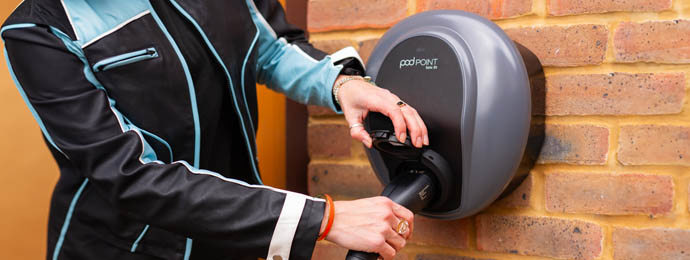
Can you charge an electric car at home?
Yes, you can charge an electric car at home, with most EV charging in the UK taking place at home typically overnight.
Getting an electric car charging station installed at home is typically the most convenient and cost-effective way to keep your EV battery charged.
You can learn more about electric car charging in our electric car charging points guide.
How to charge an electric car at home
If you charge your electric car at home, it's a good idea to have a home charging point installed. A home charger is a small waterproof box with a charging wire or a socket for plugging in a portable charging cable that mounts to a wall.
Most drivers prefer a dedicated home charging port since it has built-in safety features and can charge your vehicle faster. You can use an EVSE supply cord for a three-pin plug outlet as a backup. However, charging via a three-pin plug is not a long term solution and should be kept for occasional or emergency use.
You can read more about electric car charging in our in our electric car charging points guide.
“A smart EV charger is a convenient, fast, and reliable way to charge your electric car at home. In 2022, 80% of EV drivers charge their vehicle at home, with 35 million home EV chargers estimated to be installed globally by 2026.”

How to get an electric car charging point installed at home
When installing an electric car charging point at home, the unit must be professionally installed. Most qualified charging providers include the installation cost in the unit's price.
The installation process requires wall mounting the charge point on an exterior wall or garage close to where you park and fixing it securely to the mains electricity supply.
Typically an installation takes around three hours to complete, depending on the individual requirements and the complexity of the installation. However, it's wise to be at home during your install as the charging provider will install a charge point in the most convenient location for you and will demonstrate how to charge your car, along with answering any questions you may have.
We recommend using Pod Point when installing a home charging point. However, we are happy to provide free advice and answer any questions you may have as it's totally up to you which provider you choose to use.
What are the different types of home EV chargers available?
There are two main types of home wall box chargers for electric vehicles: a universal charge point and a tethered charge point.
Different types of home EV chargers
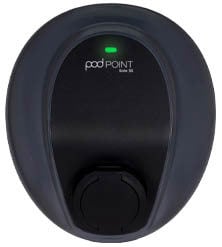
Universal Charge Point
Universal charge points, also called socketed charge points, are compatible with all plug-in electric cars and are ideal for vehicles with different connector types. The portable cable is typically sold separately from the vehicle, although they're often purchased with the vehicle.
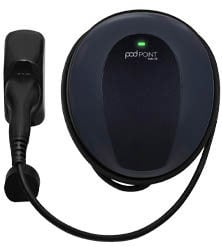
Tethered Charge Point
Tethered charge points have a permanently attached charging cable and are available with a Type 1 or Type 2 connector. The cable usually wraps around the charging point, allowing the cable to be easily hidden away.
Cost of installing a dedicated home charger
The cost of a home EV charger varies depending on several factors, including the charger's speed and the type of installation required. Still, you may be eligible for a government OZEV grant to help keep costs down.
If you order a home EV Charger with Pod Point via Nationwide Vehicle Contracts, fully installing a home charging point costs £1099, and once installed, you only have to pay for the electricity you use.
Check out our electric car charging costs guide to learn more about the cost of charging at home.
Am I eligible for a home EV charger?
To be eligible for a home EV charger, you need to have:
- Dedicated off-street parking
- Permission from your landlord (if you're renting)
- A good Wi-Fi connection at your property or a SIM router with a 3G or 4G SIM
- Be situated in mainland Great Britain
- Registered as the owner or driver of an EV (including most plug-in hybrids)
To have a home charger installed, you must also have dedicated off-street parking. You can not have a home charger installed if you do not own the parking or have the sole legal right to the space.
This includes:
- Spaces shared with other properties
- Rented spaces
- Spaces that offer access routes to other properties
The parking must be appropriate for a charge point installation which the installer will conduct a survey before installation. The parking must be eligible for the vehicle to be charged safely and have access to the parking space at all times.
What is typically included with standard installation of a dedicated home charger?
A standard installation package for the home charge point typically includes:
Standard installation typically includes:
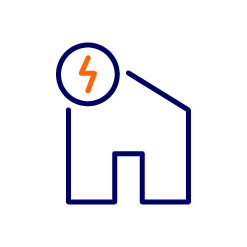
Fitting to a permanent structure
Fitting the chargepoint on a brick or plaster wall or another appropriate permanent structure.

Cabling
Cabling clipped to the wall between the electricity supply meter/distribution board and the chargepoint.

Testing of electrical connections
The fitting and testing of electrical connections and safeguards required for the chargepoint.

Electrical Certificate
An electrical certificate demonstrating that your installation complies with UK regulations
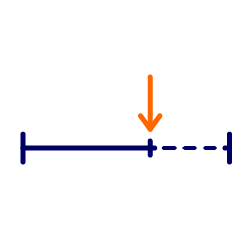
Plastic Conduit
Up to 3 metres (10 feet) of plastic conduit to hide interior wiring. If required, an earth rod in soft ground.
What's typically excluded with standard installation of a dedicated home charger?
Standard installation of a home charger usually excludes:
Standard installation typically excludes:

Non allocated off-street parking location
Install of a chargepoint that's not in an allocated off-street parking location and at a height that prevents it from being struck by a car.

Additional cabling
Cabling higher than 1.8 metres (6 feet) above the ground. If the chargepoint is required to be fixed higher than 1.8 metres, you may need to be requoted for any extra work required.

Trenching underground
Trenching the cable underground or suspending it above ground.

Cabling under floorboards or ceiling
Running cable under floorboards or through ducting ceiling voids or wall voids without a drawcord (to pull the cable through). The provider can't take responsibility for replacing flooring or other building materials after the cable has been laid.

Unsafe conditions
The provider's specialists cannot work in crawl spaces, roofs, or lofts if deemed unsafe. They can also not work in extreme weather (i.e. flooding or heavy rain).
What happens on the day of installation
Before the installation, your installer will confirm their arrival time with you. Based on your power supply and how you park your car, the installer will assist you in determining the ideal location for your charger.
Your installer will first drill and clip the cable to the wall to position and fix the charger, then turn off the power while installing the RCBO and connecting it to the main supply. They'll then perform final safety checks to ensure that your home charger is ready to use.
Next, your installer will give you a thorough demonstration of your charger, including what the various lights mean and how to contact them if you have any more questions.
Finally, your Wi-Fi password will be required to complete the installation of your home charger.
Can I connect by EV into a 3-pin plug socket?
Yes, electric cars are always supplied with a cable designed for a three-pin domestic plug socket. However, charging via a three-pin plug should be kept for occasional or emergency use. Manufacturers recommend keeping this cable in your car as a backup, but not for regular use.
You can read more on electric car charging in our electric car charging points guide.
I live in an apartment or flat, can I still have a home EV charger?
If your apartment/flat meets installers charge point installation requirements, there should be no issue installing one. But typically, home chargers aren't accessible for residents in apartments/flats as most customers don't meet the installation requirements.
However, suppose there isn't currently any home charger infrastructure available. You can ask your property manager to contact installers such as Pod Point, who offer home EV charging for apartments and flats.
Guide Information
Originally published: 18th January 2022
Last updated: 18th January 2022
